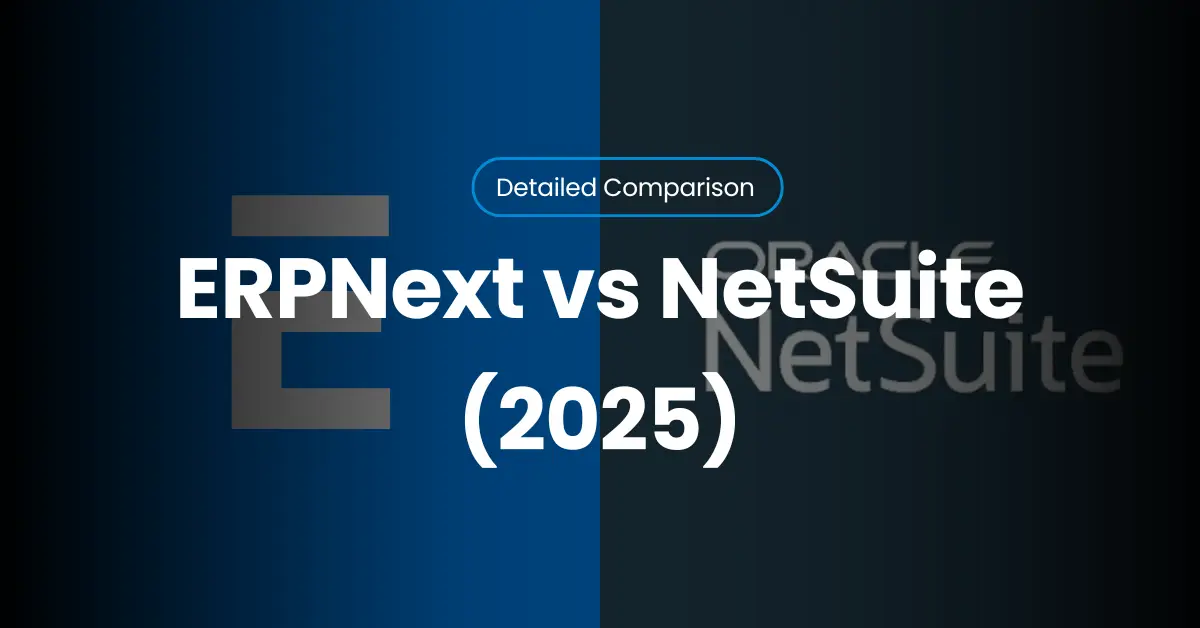Modern manufacturing is increasingly complex. Factory floors generate massive amounts of data — from raw material inventories to production schedules and quality checks. Relying on spreadsheets or disconnected systems often leads to errors, inefficiencies, and missed insights.
Enterprise Resource Planning (ERP) systems provide a structured way to integrate manufacturing processes, finance, HR, inventory, and supply chain operations. They offer automation, real-time visibility, and analytics that help manufacturers make better decisions, faster.
Two popular contenders in this space are ERPNext and NetSuite. Both promise to streamline production, enhance control, and support growth. Yet their approaches differ significantly, especially in pricing, scalability, and customization. This guide breaks down the ERPNext vs NetSuite differences for manufacturers, helping you choose the right ERP for your business.
The ERP Showdown — ERPNext and NetSuite in Manufacturing
Manufacturers often face a choice between open-source flexibility and enterprise-grade cloud solutions. ERPNext and NetSuite represent these two approaches. Understanding their origins, target users, and system architecture is crucial before evaluating features.
What Is ERPNext?
ERPNext is an open-source ERP built on the Frappe framework. It provides strong manufacturing modules such as Bill of Materials (BOM), work orders, and production planning. Companies appreciate its flexibility: you can host it on your own servers or use cloud deployment. For SMBs, this can be a cost-efficient ERP solution that adapts to specific manufacturing processes without heavy licensing fees.
What Is NetSuite?
NetSuite, owned by Oracle, is a cloud-based ERP tailored for mid-sized to large enterprises. It integrates finance, inventory, CRM, and manufacturing modules in a single SaaS platform. Manufacturers value NetSuite for scalability, prebuilt integrations, and enterprise-level support. Its subscription model ensures regular updates, but costs can rise with more users or modules.
Manufacturing Features That Matter Most
Not all ERP features are equally relevant on the factory floor. Manufacturers need tools that enhance production efficiency, inventory control, and visibility. Comparing ERPNext and NetSuite on these core areas reveals their practical impact.
Production Planning and Control
Both ERPNext and NetSuite manage MRP, work orders, and job cards, but they approach it differently:
| Feature | ERPNext | NetSuite |
| Production Planning | Flexible, modular workflows | Standardized, enterprise-grade |
| Work Orders | Customizable per production line | Prebuilt templates, scalable |
| Material Requirements Planning | BOM-driven, open-source control | Cloud-integrated, real-time |
ERPNext allows manufacturers to adjust workflows to local production realities, while NetSuite provides structured processes suited for multi-plant operations.
Inventory, Procurement, and Supply Chain Management
Effective inventory and procurement management directly affect cost control. Key capabilities include:
- ERPNext: Real-time stock tracking, automated reorder alerts, vendor management.
- NetSuite: Centralized inventory across multiple sites, integrated procurement workflows, and detailed supplier analytics.
Both platforms improve traceability and warehouse efficiency, but ERPNext gives SMBs more flexibility, while NetSuite excels for enterprise-scale SCM.
Quality and Maintenance Management
Quality assurance is critical in manufacturing. Both ERPs offer tools for inspection logs, maintenance schedules, and preventive actions. ERPNext enables custom quality checkpoints at every production stage. NetSuite provides compliance tracking and automated alerts suitable for large-scale operations with stringent regulatory requirements.
Pricing and Total Cost of Ownership (TCO)
Selecting an ERP goes beyond initial licensing. Manufacturers must account for implementation, hosting, training, and long-term maintenance. Understanding the total cost of ownership (TCO) helps avoid unexpected expenses.
ERPNext Pricing Model
ERPNext offers free core modules, making it attractive for small and medium-sized businesses (SMBs). But ERPNext pricing also offers paid options, including cloud hosting or enterprise support. Since it’s open-source, customization costs depend largely on internal resources or external consulting. This flexibility can keep overall costs lower than traditional ERP systems.
NetSuite Pricing Model
NetSuite operates on a subscription basis, charging based on users and modules. Enterprise-level support and cloud infrastructure are included, but licensing fees can scale quickly with additional users or advanced manufacturing modules. While predictable, these costs are generally higher than ERPNext, especially for SMBs.
Hidden Costs of Customization and Support
ERP implementations often include costs beyond licenses:
- Consulting and configuration for production workflows.
- Training and onboarding for shop floor staff.
- Third-party integrations with CRM, eCommerce, or accounting systems.
- Ongoing maintenance and version upgrades.
Manufacturers underestimate these expenses, so factoring them into the ERPNext vs NetSuite total cost of ownership analysis is critical.
Ease of Use, Deployment, and Ongoing Support
An ERP’s success is tied to adoption. If shop floor staff or management struggle with the interface, productivity gains may never materialize.
User Experience and Interface
ERPNext emphasizes simplicity, with dashboards and modules that are easy to adapt to manufacturing workflows. Users can customize views without advanced technical skills. NetSuite, in contrast, provides structured interfaces that scale well for multi-plant operations but may require more training upfront.
Implementation Complexity
ERPNext supports both self-hosted and cloud deployments, offering flexibility but requiring careful setup. NetSuite’s fully managed cloud platform reduces IT overhead but involves a more rigid implementation path. Typical ERP implementation timelines vary: ERPNext for SMBs may take a few months, while NetSuite for enterprises can extend 6–12 months.
Support, Documentation, and Community Help
- ERPNext: Strong open-source community, extensive documentation, and optional paid support.
- NetSuite: Vendor-provided support, dedicated SLAs, structured training programs.
The takeaway: ERPNext favors businesses with technical capability and a desire for flexibility, while NetSuite excels in environments needing structured support and enterprise-level assistance.
Scalability, Performance, and Cloud Flexibility
Manufacturing businesses grow — sometimes quickly. Your ERP must handle increasing production lines, multiple locations, and larger datasets without slowing down.
ERPNext Cloud and Self-Hosted Options
ERPNext allows both cloud and on-premise hosting. Companies can start small, scaling modules and users gradually. This modular scalability is ideal for SMBs or specialized manufacturing processes, where flexibility and customization matter.
NetSuite’s Cloud Infrastructure
NetSuite’s cloud architecture offers high uptime, global accessibility, and multi-location support out of the box. Enterprises benefit from a predictable performance profile, with updates and security handled centrally.
Which Scales Better for Growing Manufacturers?
- ERPNext: Modular growth, cost-effective scaling, adaptable workflows.
- NetSuite: Enterprise-grade scaling, robust analytics, automated updates.
For SMBs aiming to expand, ERPNext can scale steadily without huge subscription jumps. Larger manufacturers may prefer NetSuite’s ready-made scalability and multi-site orchestration.
Manufacturing Automation and Integration Capabilities
Modern manufacturing relies on automation, connected systems, and seamless data flows. Both ERPNext and NetSuite enable integration, but the approach and flexibility differ.
Built-in Manufacturing Modules
| Module / Feature | ERPNext | NetSuite |
| Work Orders | Fully customizable, adaptable to SMBs | Standardized, enterprise-ready |
| Production Tracking | Real-time, with open-source flexibility | Centralized, cloud-integrated |
| Material Movement Automation | Supports IoT and sensor data via API | Prebuilt workflows for large-scale plants |
ERPNext is particularly suited for SMBs that need modular customization, while NetSuite provides a plug-and-play solution for enterprises with complex, multi-site production lines.
Third-Party Integrations (CRM, eCommerce, Accounting)
- ERPNext: Flexible APIs allow integration with Shopify, WooCommerce, and custom accounting or HR systems.
- NetSuite: Prebuilt connectors for CRM, accounting, eCommerce, and advanced analytics.
In practice, ERPNext gives hands-on control, whereas NetSuite reduces the time and effort needed for integration at scale.
Data Security and Compliance Confidence
Sensitive manufacturing data — including supplier details, BOMs, and production logs — must be protected. Regulatory compliance is equally critical.
Role-Based Access and Permissions
Both platforms support granular access controls, ensuring staff access only to what they need. ERPNext allows custom roles per department, while NetSuite comes with enterprise-standard permission structures.
Backup, Recovery, and Data Privacy
- ERPNext: Flexible backup strategies; self-hosted or cloud recovery options.
- NetSuite: Automated cloud backups, disaster recovery, SLA-guaranteed uptime.
Compliance Support (ISO, FDA, etc.)
ERPNext and NetSuite help maintain audit trails and traceability. NetSuite’s cloud tools often include automated compliance reporting for regulated industries, whereas ERPNext allows tailored workflows to meet specific quality or regulatory requirements.
ERPNext vs NetSuite — Which Fits Your Manufacturing Business Best?
Deciding between these two ERP systems requires assessing business size, growth plans, and technical capability.
Choose ERPNext If You Want…
- Open-source flexibility and modular customization
- Lower TCO for SMBs
- Self-hosting or cloud deployment options
- Tailored manufacturing workflows
Choose NetSuite If You Need…
- Enterprise-grade automation and analytics
- Ready-made integrations across global operations
- Vendor-managed cloud infrastructure
- Multi-site, multi-currency, and high-volume scalability
“At Infintrix Technologies, we’ve helped manufacturers implement ERPNext tailored to operations — ensuring it fits the business, not the other way around.”
Real-World Manufacturing Use Cases
ERPNext in a Mid-Sized Food Manufacturer
A regional food manufacturer implemented ERPNext to manage BOMs, inventory, and production scheduling. Within months, reporting accuracy improved, work order delays dropped, and cost control became more transparent.
NetSuite in a Large Automotive Supplier
A multi-location automotive supplier adopted NetSuite to centralize supply chain management, quality control, and finance. The cloud ERP enabled real-time visibility across plants and automated multi-site reporting, supporting global operations effectively.
Conclusion — ERPNext vs NetSuite: The Smarter Choice Comes Down to Fit
Both ERPNext and NetSuite bring powerful manufacturing ERP capabilities, but the best choice depends on your business context. ERPNext is ideal for cost-conscious SMBs seeking flexibility, while NetSuite excels in enterprise environments requiring turnkey cloud solutions.
“If you’re evaluating ERPNext for manufacturing, Infintrix Technologies can help plan, customize, and deploy it strategically — delivering measurable ROI.”
FAQs About ERPNext vs NetSuite for Manufacturing
H3: Which ERP is more cost-effective for manufacturers in 2025?
ERPNext generally offers a lower TCO for SMBs, while NetSuite’s subscription fees scale with users and modules.
H3: Can ERPNext handle complex multi-plant operations?
Yes — with careful configuration and proper module setup, ERPNext can support multiple plants, though NetSuite may provide faster out-of-the-box multi-site management.
H3: How does NetSuite compare in terms of implementation time?
NetSuite’s managed cloud approach typically accelerates enterprise deployment, while ERPNext implementations may require longer setup for self-hosted or highly customized workflows.
H3: Is ERPNext suitable for large-scale manufacturing?
Yes, particularly for companies comfortable managing open-source infrastructure and customizing workflows to fit production needs.
H3: Can ERPNext integrate with systems like Shopify or WooCommerce?
Absolutely — ERPNext provides APIs and connectors for seamless integration with eCommerce, CRM, and accounting tools.
H3: Who can help with ERPNext implementation and customization?
Manufacturers often partner with Infintrix Technologies to tailor ERPNext workflows, train staff, and ensure smooth adoption.
Related Articles:
Frappe vs ERPNext – Which One to Implement First 2025
ERPNext vs Odoo vs SAP Business One: A Quick ERP Comparison for Manufacturers
ERPNext vs QuickBooks: Which Is Better for Your Business in 2025?
ERPNext vs Tally: Which One Is Right for Your Business in 2025?
ERPNext vs Dolibarr: Best ERP for SMEs in 2025?
ERPNext or SAP: Which ERP Software Should Your Business Invest In?

